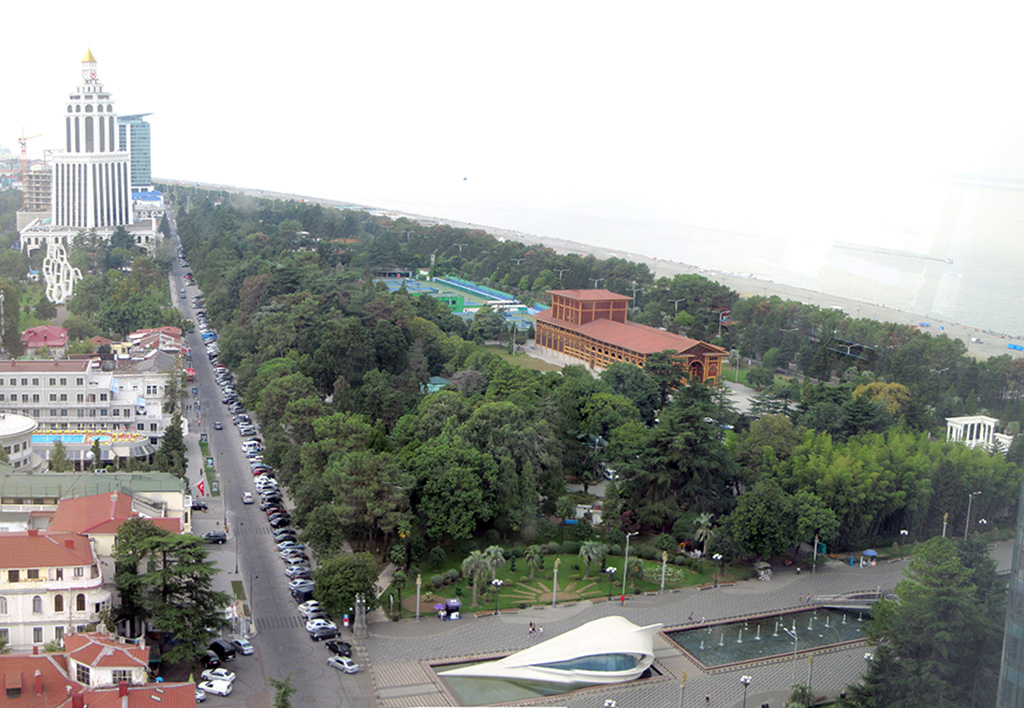

Batumi, Seaside Park Area – Seaside Boulevard
Brief Description of the Monument:
Batumi Boulevard stretches as a wide strip along the seashore, situated between the beach and the edge of the city s urban development. It is bordered on one side by E. Ninoshvili Street and on the other by the sandy beach. One notable architectural monument within the boulevard is the Seaside Colonnade (built in the 1930s). A registered monument, the Summer Theater (constructed in 1948 by architects K. Javakhishvili and B. Kirakosyan) was destroyed by fire in 1996. It was reconstructed in 2011 as an adapted modern venue.
The Batumi cape was formed by alluvial sand deposited by the Chorokhi River, and in the early 19th century, the sea extended as far inland as the present-day boulevard. By the end of the 19th century, the accumulated sand gradually formed a beach, allowing the sea to recede and enabling the creation of a seaside garden.
The development of Seaside Park began at the end of 1881. At that time, Batumi already had a plan for constructing a city garden. From the memoirs of David Kldiashvili, we learn that the plan was supported by Police Chief Colonel Voznesensky, who brought an elderly German gardener named Ressler from Poti. Ressler brought with him 500 decorative seedlings and began greening the city. After his death, he was succeeded by a French gardener, D’Alphonse, and in 1888, Ressler’s pupil, N. Tqebuchava, took over.
Initially, because of the proximity to the sea, the boulevard featured two pedestrian alleys. Only in 1895, when the sea had retreated and the coastline expanded, did it become possible to create a beach. At the time, the park’s area was 5 hectares, stretching 1,000 meters in length and between 19 and 53 meters in width. On Batumi’s 1900 city plan, the boulevard was already well-developed. It stretched for nearly one verst (approx. 1.1 km) and was considered one of the finest in the Russian Empire.
At the time, the boulevard included a buffet-restaurant, music rotunda, reading room, and a physical development society plot featuring a velodrome, tennis courts, skating rink, gymnasium, and more. At the beginning of the boulevard was a medical facility with seawater baths. The beach had both free and paid (well-equipped) swimming areas.
Between 1949 and 1951, the park was expanded, extending from the sports complex to the Batumi Pedagogical Institute, and featured wide, green-covered walkways. Later, tennis courts and a sports complex (Dinamo Stadium) were added, along with various pergolas and café-bars, whose forms evolved over time.
Among these, the uniquely designed café (Fantasia), built in 1975 in the southwestern part of the boulevard, stands out. It was designed by architect G. Chakhava and artist Z. Kapanadze. The area also featured amusement rides and attractions.
Today, the boulevard stretches over 2 km and covers an area of 21 hectares. On the seaward side, two 6-meter-wide asphalted alleys are arranged, separated by lawns.
The Seaside Park remains one of Batumi’s most important landmarks and cultural attractions.